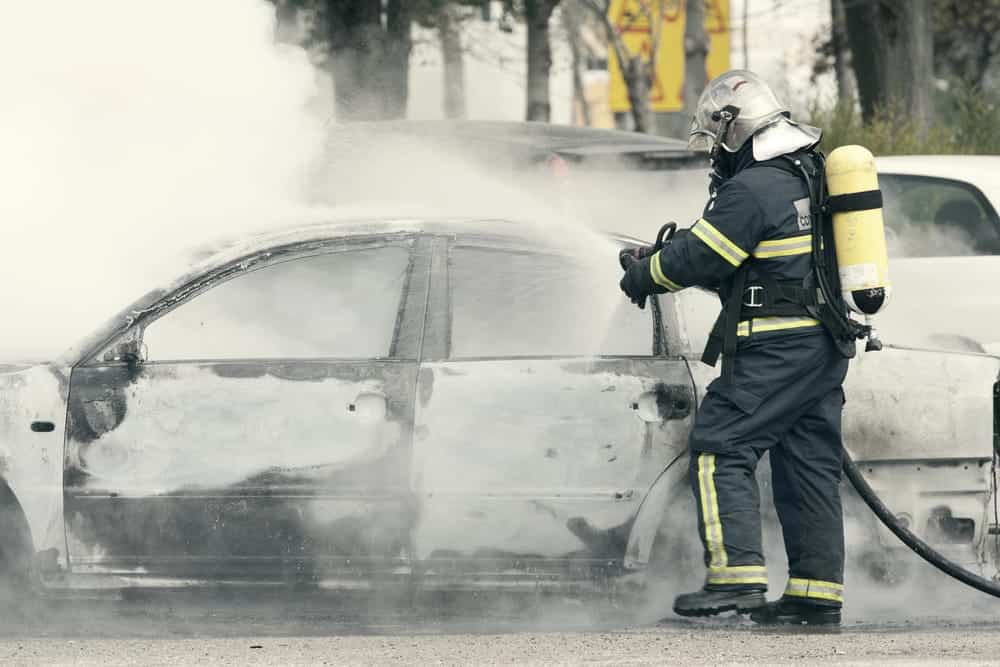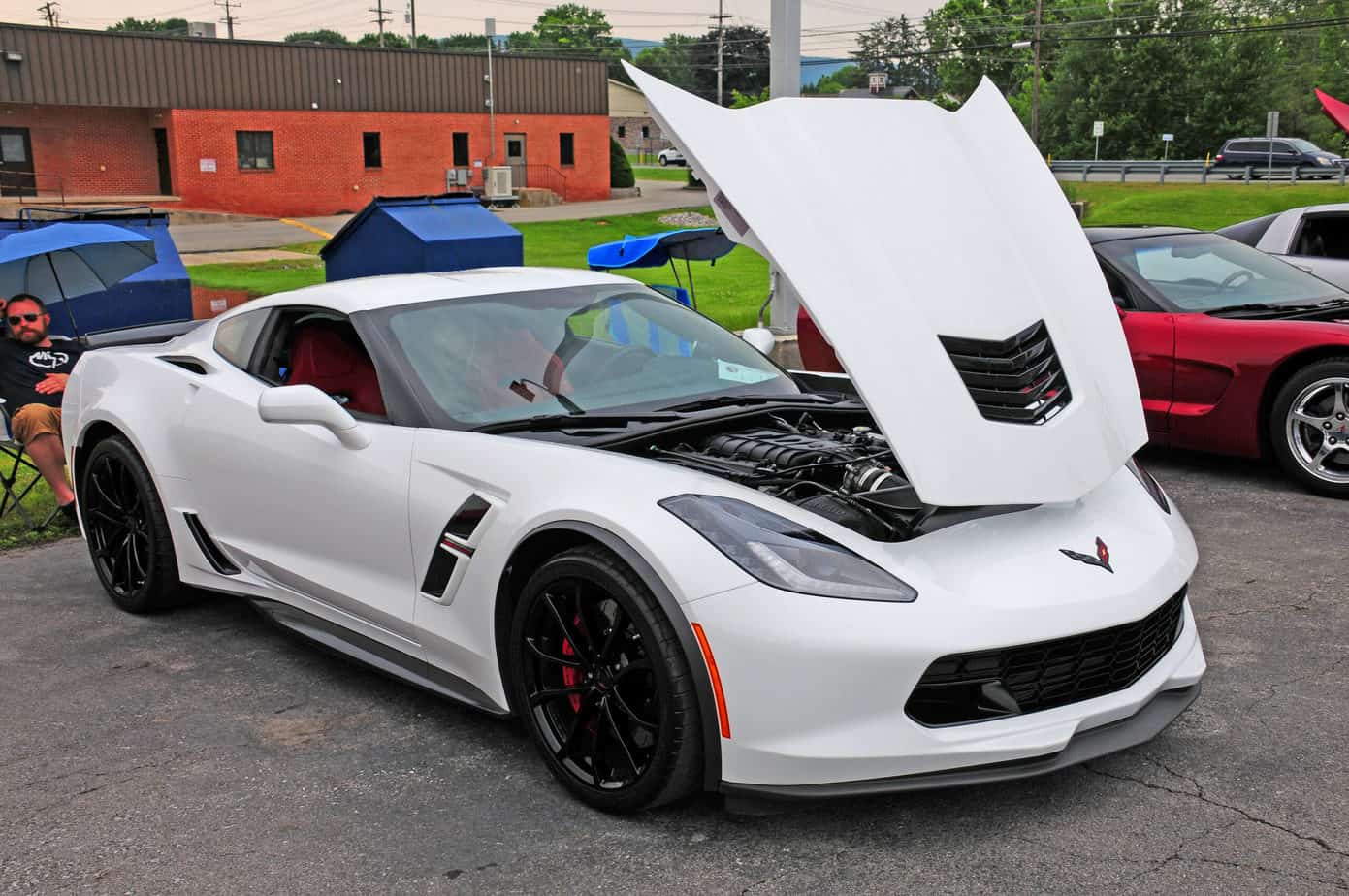As the shift towards electric vehicles (EVs) continues to accelerate, the spotlight has inevitably fallen on the safety risks associated with this new technology. In particular, the risk of electric car fires, specifically in EVs, has become a pressing concern, sparking debates about their safety compared to traditional cars.
But how substantial is this electric car fire risk, really? Let’s unravel the facts and dispel the myths.
Key Points
- Electric vehicles (EVs) are less likely to catch fire than gasoline-powered cars; however, when EV fires do occur, they pose unique challenges including higher burning temperatures and potential for reignition.
- High-profile incidents of electric car fires have spurred manufacturers to improve safety protocols and have significant legal and financial implications, affecting consumer confidence and pushing for greater industry accountability.
- The safety of EVs is continuously being enhanced through innovations in battery technology and design, stringent regulatory safety standards, and specialized training and resources for emergency response to EV fires.
Electric Car Fires
Despite the growing concern, the reality is that electric cars present a different set of fire risks compared to their gasoline counterparts, including electric vehicle battery fires.
The primary cause of these fires is often the battery pack, a critical component that stores the energy necessary to power the vehicle. When something goes wrong with these batteries, such as a manufacturing defect or physical damage from a collision, it can lead to what’s known as thermal runaway—a chain reaction that can result in a battery fire.
Contrary to popular belief, electric vehicle fires, while they do occur, are not as commonplace. In fact, research has shown that electric vehicles are less likely to catch fire compared to gasoline-powered cars.
Even so, extinguishing these fires poses significant challenges for firefighters due to their higher and prolonged burning temperatures, substantial water requirement, and potential for reignition even after being put out.
High-profile incidents, such as the NIO ES8 self-ignition incident in Shanghai, have raised concerns about the safety of electric cars.
Despite these incidents, manufacturers have been quick to address them and improve safety measures. It’s clear that while the risk is present, it’s far from being a common occurrence, and manufacturers are making strides in ensuring their vehicles are safe.
Thermal Runaway in EV Batteries
One of the main factors contributing to electric car fires is a phenomenon known as thermal runaway. This is a chain reaction that occurs within the battery cells, leading to rapid temperature and pressure increase.
If not controlled, thermal runaway can result in a fire. It can be triggered by various causes such as faults, crash scenarios, or defects in the cells.
Grasping and controlling this phenomenon forms an integral part of EV safety. It is why manufacturers are continually investing in technologies and designs that can mitigate the risk of thermal runaway.
By better understanding this process, we can develop more effective ways to prevent it and reduce the incidence of EV fires.
Frequency of Electric Car Fires vs. Gas Vehicles
The statistics regarding the frequency of EV fires might astonish you. Despite the high-profile incidents and widespread media coverage, EV fires are not as common as they might seem.
Research has shown that electric vehicles are less likely to catch fire compared to petrol or diesel cars. In Sweden, for example, the likelihood of a gasoline-powered passenger vehicle catching fire was found to be 29 times higher than that of EVs and hybrids.
This doesn’t undermine the risks linked to EV fires, but rather provides a broader viewpoint. Like any technology, electric vehicles come with their own set of challenges and risks, and it’s crucial to be aware of them.
However, it’s equally important to understand that these risks are being actively managed and mitigated through ongoing research, development, and stringent safety standards.
High-Profile Electric Car Fire Incidents
Despite their rarity, high-profile EV fire incidents have undoubtedly caused a commotion. One such incident involved a Tesla vehicle that caught fire following a crash, raising questions about the safety of electric vehicles.
Despite the media attention these incidents garner, it’s crucial to remember that they represent a small fraction of the total number of EVs on the road. In fact, Tesla’s car fire instances were found to be 11 times lower than the average vehicle in the United States.
Reacting to these incidents, manufacturers have adopted proactive measures to bolster safety protocols. This includes:
- Initiating recalls
- Enhancing battery safety features
- Improving emergency response protocols in accordance with recommendations from the National Transportation Safety Board (NTSB)
These actions not only improve vehicle safety but also serve to boost consumer confidence in electric vehicles, as compared to petrol and diesel vehicles.
Lawsuits from EV Fires
Along with the technical and safety challenges, the rise of electric vehicles has opened a new front in the legal landscape.
With the increase in EV popularity, safety-related lawsuits have also seen an uptick. These legal battles involve allegations of defects in lithium-ion batteries and other components causing spontaneous fires.
The resolution of these lawsuits often involves addressing the safety of electrical systems in electric vehicles.
The industry has significantly been impacted by these lawsuits. They have not only resulted in financial costs for the manufacturers but have also led to increased scrutiny on their safety practices.
Manufacturers are now under greater pressure to improve safety standards and take more responsibility for the vehicles they produce.
The legal battles surrounding EV fires are not just a concern for the manufacturers. They also have implications for consumers, affecting their confidence in electric vehicles.
These lawsuits serve as a reminder of the potential risks associated with EVs, prompting consumers to consider safety as a critical factor when choosing an electric vehicle.
Lawsuits Involving Electric Car Manufacturers
Several high-profile lawsuits have been filed against major EV manufacturers, highlighting the legal challenges these companies face. Some examples include:
- Tesla, which has faced accusations related to defective electrical systems and battery fires due to suspension failure
- A class action lawsuit alleges battery defects in Hyundai Kona and Ioniq EVs
- BMW, which is facing a $2 million lawsuit in Canada
These cases demonstrate the potential legal risks and financial implications for EV manufacturers.
These lawsuits have not only resulted in financial losses for the companies involved but have also drawn public attention to the safety issues associated with electric vehicles. They have prompted manufacturers to ramp up their safety measures and ensure their vehicles meet the highest safety standards.
While these legal battles are an unfortunate part of the EV landscape, they play a crucial role in pushing the industry towards greater safety and accountability.
Consumer Confidence and Manufacturer Accountability
The impact of these legal battles on consumer confidence cannot be underestimated. Incidents of electric car fires can raise concerns about the safety of these vehicles, and lawsuits only amplify these concerns.
Videos of electric car fires can create a perception that electric cars are more prone to fires, raising concerns among potential buyers.
However, the impact of these incidents on electric car sales appears to be limited. Despite the media attention and the lawsuits, electric vehicles remain a popular choice among consumers.
The risks associated with battery fires are being actively addressed by manufacturers through the implementation of advanced safety features and protocols. The ongoing legal battles serve to push manufacturers to prioritize safety and take greater responsibility for the vehicles they produce.
Battery Pack Vulnerabilities and Safety Measures
The battery, specifically a lithium ion battery pack, is the heart of an electric vehicle, storing the energy required to power it. However, these battery packs, especially those composed of lithium-ion cells, come with their own set of vulnerabilities. These vulnerabilities can lead to serious issues such as thermal runaway, which can result in a battery fire.
Manufacturers have directed their efforts towards enhancing the battery design and incorporating safety measures to alleviate these risks. These include:
- the use of thermal barriers
- cooling systems
- fault detection systems
- physical barriers to isolate any catastrophic events
By addressing these vulnerabilities, manufacturers can significantly reduce the fire risk in electric vehicles.
Moreover, the industry is continuously innovating to improve battery safety. Current developments include:
- The use of batteries as structural components
- Carbon nanotube electrodes
- Cobalt-free technologies
- Research into solid-state, zinc-air, and sand batteries
These innovations aim to enhance safety, performance, and sustainability, helping to mitigate the risks associated with battery fires.
The Role of Battery Design in Preventing Fires
The design of a battery plays a pivotal role in forestalling fires in electric vehicles. To mitigate the risk of thermal runaway and subsequent fires, manufacturers have incorporated the following features into their battery designs:
- Thermal barriers
- Cooling systems
- Fault detection systems
- Physical barriers
In addition to these features, manufacturers are also exploring alternative materials and designs to improve safety. Some of these include:
- Using smaller battery packs
- Avoiding highly flammable liquids
- Incorporating active cooling systems for efficient thermal management
- Using sensors to optimize battery performance and extend its lifespan
Innovations in Battery Protection Technologies
Innovations in battery protection technologies are key to minimizing the risk of fires in electric vehicles. These include:
- The development of new technologies to prevent lithium battery failures
- The use of silicon in place of graphite anodes to reduce battery weight
- The application of carbon nanotube electrodes
These innovations are not only improving the safety of electric vehicles but also their performance and efficiency. For instance, the use of silicon in place of graphite anodes can reduce battery weight, which can improve vehicle performance and efficiency.
Similarly, carbon nanotube electrodes can improve battery capacity and charging speed, enhancing the overall performance of the vehicle.
Emergency Response to Electric Car Fires
Although manufacturers are playing their part in mitigating the risk of EV fires, it is just as vital for first responders to be prepared to manage these incidents when they arise.
Firefighters face unique challenges when dealing with EV fires. These include the need for specialized training, the need for specialized equipment, and the need to handle the unique characteristics of electric vehicle fires.
One of the prominent challenges for firefighters is accessing the battery cells amidst a fire. This is due to the distinct design and construction of lithium-ion batteries, which makes it difficult to access the source of the fire and apply extinguishing agents directly.
Moreover, EV battery fires have the potential to reignite even after being extinguished, requiring additional resources and specialized equipment.
To help firefighters overcome these challenges, various organizations offer guidance, training, and equipment. These include the International Association of Fire Chiefs (IAFC), the National Fire Protection Association (NFPA), and various online resources.
Through this training and support, firefighters can effectively respond to EV fires, protecting both themselves and the public.

Challenges Faced by Firefighters
Firefighters face unique challenges when dealing with EV fires, including:
- Different chemical reactions
- Accessing the battery cells
- Higher burning temperatures
- Potential for reignition even after the fire has been extinguished
This is due to the unique characteristics of lithium-ion batteries, which can result in lithium ion battery fires, a phenomenon known as thermal runaway.
Another challenge for firefighters is accessing the battery cells during a fire. The design and construction of lithium-ion batteries make it difficult to access the source of the fire and apply extinguishing agents directly.
To overcome these challenges, firefighters need specialized training and equipment, which is provided by several organizations and online resources.
Training and Resources for Fire Departments
Given the unique challenges of dealing with EV fires, it’s crucial for fire departments to have the necessary training and resources. Specialized training covers topics such as understanding lithium-ion fire behavior, vehicle and battery design, and the unique characteristics of EV fires.
In addition to training, firefighters also need specialized equipment to effectively handle EV fires. This includes equipment such as the Battery Extinguishing System Technology (BEST), which is designed to tackle battery fires.
With the right training and equipment, firefighters can effectively respond to EV fires, protecting both themselves and the public.
The Aftermath of an Electric Car Fire
The repercussions of an electric car fire can be extensive, going beyond the direct threat to life and property. Once the fire is extinguished, there are environmental considerations, such as the release of toxic gases and the disposal of damaged batteries.
In addition to the environmental impact, there are also insurance considerations. Electric vehicles can be more expensive to insure due to the unique risks associated with them, such as the potential for battery fires. This can affect the cost of ownership, potentially making electric vehicles less attractive to some consumers.
Despite these challenges, it’s important to remember that these are not insurmountable obstacles. With the right safety measures, ongoing research, and development, and stringent regulatory oversight, the risks associated with electric vehicles can be effectively managed.
Dealing with Environmental Consequences
One of the major concerns following an electric car fire is the release of toxic gases. Battery fires can produce a variety of toxic gases, including carbon monoxide, hydrogen fluoride, and sulfur dioxide.
These gases can have a significant environmental impact, causing air pollution and potentially harming wildlife and vegetation.
Another environmental concern is the disposal of damaged batteries. These batteries need to be properly disposed of to prevent the release of harmful toxins such as heavy metals into the environment.
This requires specialized recycling facilities or hazardous waste collection points, which can add to the complexity and cost of dealing with an electric car fire.
Insurance for Electric Car Owners
From an insurance perspective, EV fires present a unique set of challenges. The cost of insuring an electric vehicle can be higher than that of a traditional car due to:
- the increased risk of battery fires
- the higher cost of repairing or replacing damaged electric components
- the limited availability of repair shops equipped to handle electric vehicles
Moreover, in the event of an accident, insurance companies are more likely to deem an electric vehicle a total loss, which can result in higher claims payouts.
Despite these challenges, insurance companies have adapted their policies to account for the unique risks associated with electric vehicles. This includes coverage for battery fires and the additional costs associated with electric vehicle repairs.
While these adjustments can result in higher premiums for electric vehicle owners, they also provide greater protection against the unique risks associated with these vehicles.
Improving Electric Car Safety
Improving the safety of electric vehicles is a top priority for manufacturers, regulators, and researchers. From implementing rigorous safety standards to conducting cutting-edge research and development, efforts are underway to minimize the risk of electric vehicle fires and enhance overall vehicle safety.
Regulatory bodies have a significant part in these efforts. They have established stringent safety standards for electric vehicles, conducted rigorous crash tests, and evaluated advanced driver assistance systems. They also monitor manufacturer compliance with these standards, helping to ensure that every electric vehicle on the road meets the highest safety standards.
Additionally, research and development have a vital role in boosting electric vehicle safety. Innovations in battery technology, vehicle design, and safety features are continually being explored to improve vehicle safety and performance. Companies such as:
- Tesla
- LG Chem
- Panasonic
- Samsung SDI
are at the forefront of these efforts, driving the industry towards a safer, more sustainable future.
Regulatory Actions and Standards
Regulations and safety standards play a crucial role in enhancing the safety of electric vehicles. Regulatory bodies have established stringent safety standards for electric vehicles, including ISO 26262, which focuses on safety-related systems incorporating electrical and/or electronic systems in vehicles. Compliance with these standards is monitored to ensure that electric vehicles meet these safety standards.
In addition to setting standards, regulatory bodies also conduct rigorous crash tests and evaluate advanced driver assistance systems specific to electric propulsion. These tests and evaluations help to identify potential safety issues and ensure that they are addressed before the vehicles are sold to consumers.
Research and Development Efforts
Ongoing research and development efforts are crucial to improving electric vehicle safety. These efforts focus on:
- Advancing technologies
- Promoting confidence in the technology
- Reducing costs
- Exploring alternative materials, design, and safety features in EV battery technologies
- The ongoing evolution of electric vehicles through advancements in battery technologies.
By pushing the boundaries of what’s possible, researchers and developers are driving the industry towards a safer, more sustainable future.
Summary
While electric vehicle fires pose unique challenges, these risks are being actively managed and mitigated through ongoing research, development, and stringent safety standards. Manufacturers, regulatory bodies, and researchers are all working together to enhance the safety of electric vehicles, drive innovation, and reduce the incidence of battery fires.
As consumers, it’s crucial to stay informed about these issues and to make safety a priority when choosing an electric vehicle.
Frequently Asked Questions
What is the biggest problem with an electric car fire?
The biggest problem with electric vehicle fires is the potential for a dangerous chain reaction called “thermal runaway,” where the fire can spread to the rest of the battery cells. This can lead to a self-generating heat and the propagation of the fire from cell to cell.
Are lithium-ion batteries safe in cars?
Lithium-ion batteries have some safety concerns, such as the risk of fire or explosion if damaged or overheated. However, they generally have a lower risk of fire explosions compared to conventional vehicle gasoline.
How hot does an electric car fire get?
EV fires can burn at approximately 5,000 degrees Fahrenheit, compared to a gas-powered vehicle fire which burns at about 1,500 degrees Fahrenheit. This makes controlling EV fires more challenging.
Are electric car fires more common?
No, electric car fires are not more common. Research shows that electric vehicles are less susceptible to fires than internal combustion engine vehicles. In fact, the available data suggests that the fire risk is significantly lower for electric cars compared to petrol and diesel vehicles.
What are some of the high-profile electric car fire incidents?
Some high-profile electric vehicle fire incidents include the NIO ES8 self-ignition incident in Shanghai and incidents involving Tesla vehicles. It’s important to be aware of these cases to understand the safety considerations related to electric vehicles.
Start a free, no-obligation case review today with an experienced product defect lawyer.
Get a Free Case Review
- Pay nothing unless you win
- Millions recovered
- 27+ years experience




